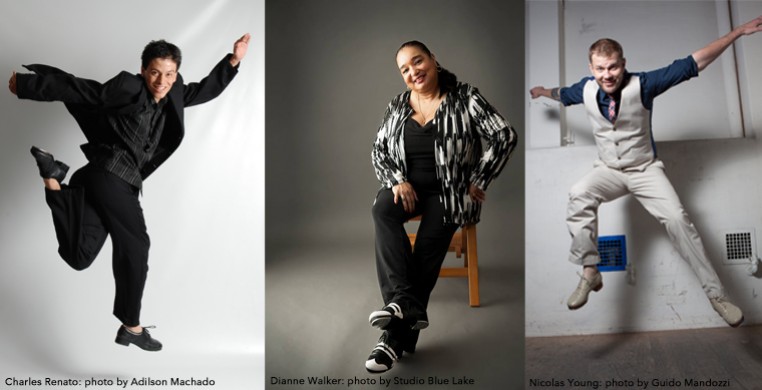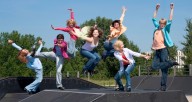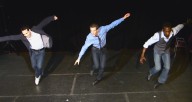When Chicago tap dancer Jay Fagan first entered The American Rhythm Center, home of the Chicago Human Rhythm Project (CHRP) and its resident tap company, BAM!, he was blown away by the vibe “of all these amazing dancers!” And they were all wearing tap shoes. “I’m home!” he said, and rightly so. Smack dab at the intersection of Michigan Avenue and Congress Parkway, The American Rhythm Center studios look out on a scene that fairly screams “Chicago”--Lake Michigan, Grant Park, Michigan Avenue, and those awesome Native American statues on horses welcoming all to the Windy City!
Fagan joins an international roster of renowned tap dance artists who will be performing this week in JUBA!, winding up CHRP’s annual Rhythm World festival with dance concerts at the Museum of Contemporary Art. JUBA!, which means “King,” references William Henry Lane, the first black man allowed to dance on the white minstrel stage in the late 1800’s. He was nicknamed “Juba” as the champion dancer on the circuit, with unparalleled mastery of complex rhythms. The scope, variety, and extraordinary virtuosity of dance on display throughout three separate JUBA! programs (Wednesday, Thursday, and Saturday nights) is testimony to the global proliferation of tap and percussive dance and its increasing popularity on the concert dance stage. While this season focuses on the European Union, Chicago tap artists have a healthy presence, including Fagan, Lane Alexander, Bril Barrett, Martin Bronson, Star Dixon, Tre Dumas, Nico Rubio, Jumaane Taylor, and Zada Cheeks.
Rhythm World, now in its 24th season, is America’s oldest and most comprehensive festival of tap and contemporary percussive dance, drawing students and professionals from all over the world for a four-week immersion in tap dance and percussive arts. Founding director Lane Alexander, who also trained in musical theater, ballet, and modern dance, got his first real taste of what tap dance was all about at the Oregon International Tap Festival. “I thought I knew how to tap dance,” he says of the experience, “but (once there) I realized no one EVER knows how to tap dance. There is no one way.” When the body is your instrument, he observes, “everyone makes music in a different way. You have to explore your instrument until it makes the sound you want.”
Embracing the diversity of tap dancing going on in small enclaves throughout the city, Alexander saw a need in Chicago to get everyone together to share a concert. “We shouldn’t have to go to Oregon,” he said, to experience the community, passion, and vibrancy of spirit that a festival can create. Creating The American Rhythm Center as a home for tap dance and rhythmic arts in the heart of this beautiful city was Alexander’s brain-child as well. Almost two years into operations in CHRP’s new home, things are hopping, literally, with an expanded Rhythm World festival in full swing this summer. “Our tap dance artists have to be great teachers and great performers, because this is an educational/performance festival.”
In a glass-enclosed studio overlooking Grant Park, Body Drumming master teacher Nicholas Young gets students to think about rhythm in a new way: “If your body were a trap-set....” He demonstrates a raucous combination of athletic moves vaguely reminiscent of dancing the Irish Jig with your hands and playing paddy cake with your feet on a hard-hat construction site. Seven men and women in thick-soled sneakers or boots echo Young in a cacophony of hand and foot clapping, hip and tummy slapping, shoe stomping, and heel-toe syncopations. Young, who starred in the Broadway hit “STOMP!” and looks more like a biker than a tap dancer, breaks it down, syllable by syllable, “Tock Tock Tocka-ta-tocka-ta!” With an in-your-face teaching style, he goes one-on-one, until each student gets it. Magically, the whole phrase coalesces into a gamelan-like orchestration of overlapping rhythms, which they’ve been learning for the past week of Young’s Institute For The Rhythmic Arts (IFTRA), one of the many Rhythm World courses taking place.
In another studio, Diane Walker, “Lady Di,” teaches an advanced tap class. “Think intensity, but not loud!” she says, demonstrating the phrase with an exquisite combination of articulation and lightness. Twenty pairs of tap shoes slam out a thunderous barrage of shuffles and fa-laps, Irishes and ball-changes. “It’s very matter of fact,” she smiles. “If I’m forcing, it’s too much.” Lady Di, one of America’s tap dance grandes dames, tries to elicit the touch that will set her students’ rhythm free. “Digety-diggety-bop! You hickory-dickory-dock-and-then-come-back-and-then-come-back.” Like Young in the studio across the hallway, she breaks it down syllable by syllable. “Try it to the music. Music is like training wheels on the bike, because eventually I’m gonna pull the music out!”
“It’s a melting pot of choices,” says Fagan, who started tapping at the age of five in the western suburbs. “Tap is a lot more than you think it is, way beyond steps. It’s heart and soul, family history, open to anyone who wants to do it, and it’s love!” And what could be better for the future of tap dance in Chicago than the kind of hub Alexander has created for all the diverse tap dance going on in the city?
Peggy Sutton, whose father, tap great Tommy Sutton, founded the Mayfair Academy of Fine Arts, says “tap dance translates back to the beginning--drums, Africa. It’s the only truly American dance form.” What makes tap so special? “What’s really obvious” she replies, “is the sound! I think people like it because everybody secretly would like to do it!” And many do! One of the Academy's illustrious grads is Tre Dumas, who has been teaching for Rhythm World this summer.
Chicago boasts eight professional tap dance companies. “The door is open,” says Julie Cartier, director of The Cartier Collective. With so many new, young tappers on the scene, there’s experimentation, especially in groups like Audible Odyssey, where different choreographic forms merge with improvisational performance. “The next generation are exploring their own voices,” she says. Cartier admires the incredible musicianship of some of the younger tappers on the scene, but for her, “See the music, hear the dance” characterizes her work, which puts equal emphasis on the visual and auditory aspects of the art form.
Tristan Bruns is an example of someone who has broken the mold, with his one-man show, “TAPMAN,” a physical comic book adventure story.
Mark Yonally, another original voice, founded Chicago Tap Theatre. Now in its twelfth season with a new full-length work, “Shoestrings,” premiering September 5-7 at the Athenaeum Theater, Chicago Tap Theatre is the only Chicago tap company that performs exclusively to live music. Yonally, whose background in modern dance informs his choreographic style, considers himself a modernist who also employs narrative structure to tell story through movement, rhythm, and music. His loose-ankle technique relies on the big muscles in the hips and gluteals, keeping the ankles as loose and relaxed as possible. Unlike the style of Fred Astaire or Paul Draper, he never intentionally uses a pointed toe, although you might see a flexed foot now and then. He prefers a light and skittery sound, more interested in the melodic aspect of tapping than in the percussive side of the art form. (Company auditions take place August 24th.)
MADD Rhythms founding director Bril Barrett’s mission is to preserve the history and legacy of tap, promote it as an art form, and create a future that includes experimentation and collaboration with other dance forms, like hip-hop. MADD Rhythms means “making a difference through dance,” says Barrett. “We reach out to underserved youth,” exposing young audiences and young tappers to the joy of tap dancing through outreach programs.
“Patting the Juba” is an expression that comes down to us from tap dance’s earliest beginnings in Colonial America, when British Isles Step Dancing and Clogging merged with African drumming and dancing. Today, JUBA! continues the tradition with a rich and varied festival of tap dance at its best. And it’s here in Chicago, where tap is truly home!
Lynn Shapiro
Editor








